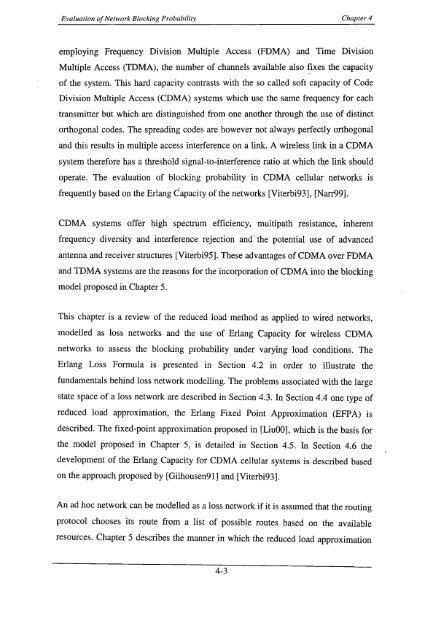Gugrajah_Yuvaan_ Ramesh_2003.pdf
Gugrajah_Yuvaan_ Ramesh_2003.pdf
Gugrajah_Yuvaan_ Ramesh_2003.pdf
Create successful ePaper yourself
Turn your PDF publications into a flip-book with our unique Google optimized e-Paper software.
Evaluation ofNetwork Blocking Probability Chapter 4<br />
employing Frequency Division Multiple Access (FDMA) and Time Division<br />
Multiple Access (TDMA), the number of channels available also ?xes the capacity<br />
of the system. This hard capacity contrasts with the so called soft capacity of Code<br />
Division Multiple Access (CDMA) systems which use the same frequency for each<br />
transmitter but whi'ch are distinguished from one another through the use of distinct<br />
orthogonal codes. The spreading codes are however not always perfectly orthogonal<br />
and this results in multiple access interference on a link. A wireless link in a CDMA<br />
system therefore has a threshold signal-to-interference ratio at which the link should<br />
operate. The evaluation of blocking probability in CDMA cellular networks is<br />
frequently based on the Erlang Capacity of the networks [Viterbi93], [Narr99].<br />
CDMA systems offer high spectrum efficiency, multipath resistance, inherent<br />
frequency diversity and interference rejection and' the potential use of advanced<br />
antenna and receiver structures [Viterbi95]. These advantages of CDMA over FDMA<br />
and TDMA systems are the reasons forthe incorporation of CDMA into the blocking<br />
model proposed in Chapter 5.<br />
This chapter is a review of the reduced load method as applied to wired networks,<br />
modelled as loss networks and the use of Erlang Capacity for wireless CDMA<br />
networks to assess the blocking probability under varying load conditions. The<br />
Erlang Loss Formula is presented in Section 4.2 in order to illustrate the<br />
fundamentals behind loss network modelling. The problems associated with the large<br />
state space of a loss network are described in Section 4.3. In Section 4.4 one type of<br />
reduced load approximation, the Erlang Fixed Point Approximation (EFPA) is<br />
described. The fixed-point approximation proposed in [LiuOO], which is the basis for<br />
the model proposed in Chapter 5, is detailed in Section 4.5. In Section 4.6 the<br />
development of the Erlang Capacity for CDMA cellular systems is described based<br />
on the approach proposed by [Gilhousen91] and (Viterbi93].<br />
An ad hoc network can be modelled as a loss network if it is assumed that the routing<br />
protocol chooses its route from a list of possible routes based on the available<br />
resources. Chapter 5 describes the manner in which the reduced load approximation<br />
4-3
















